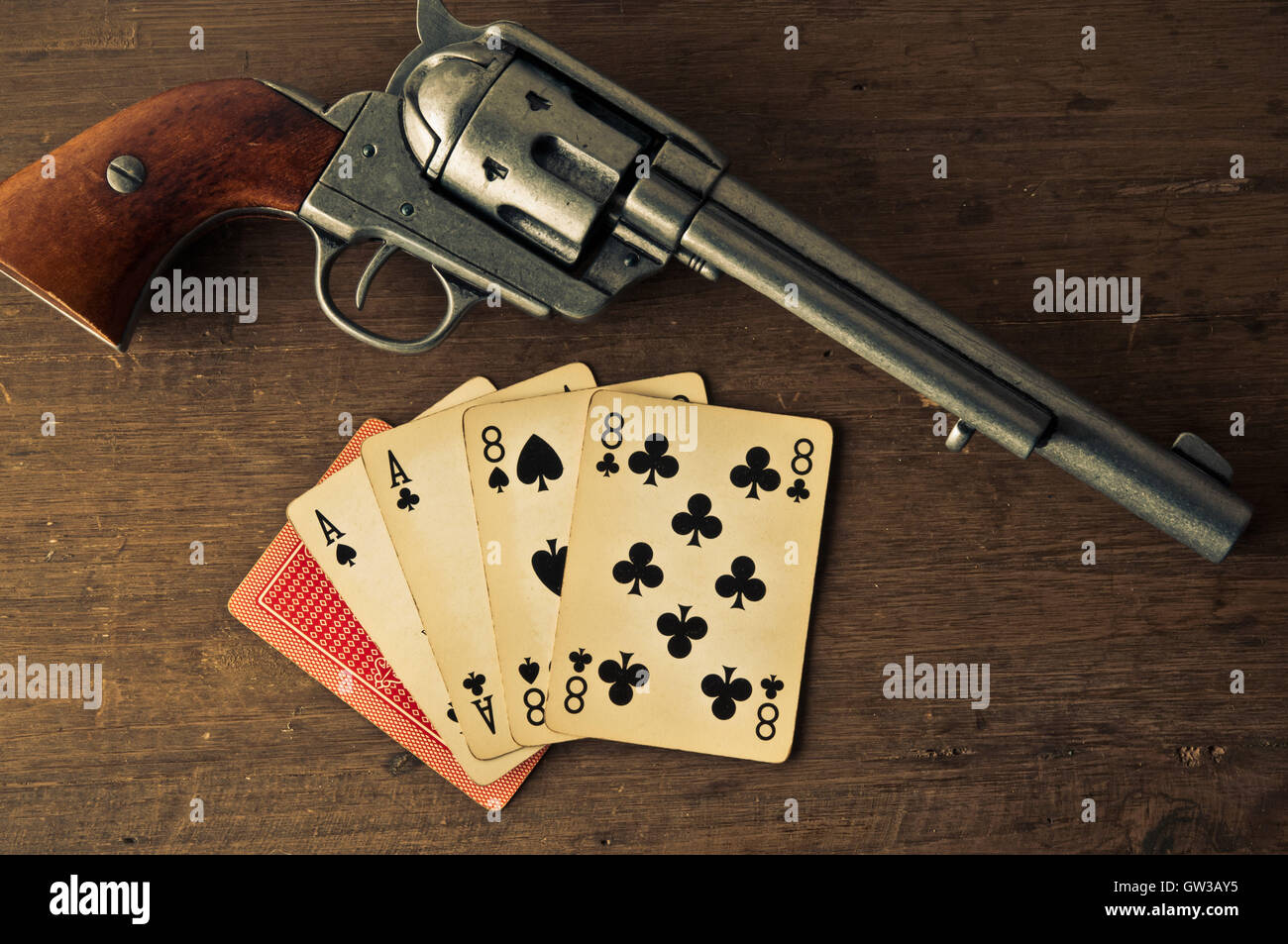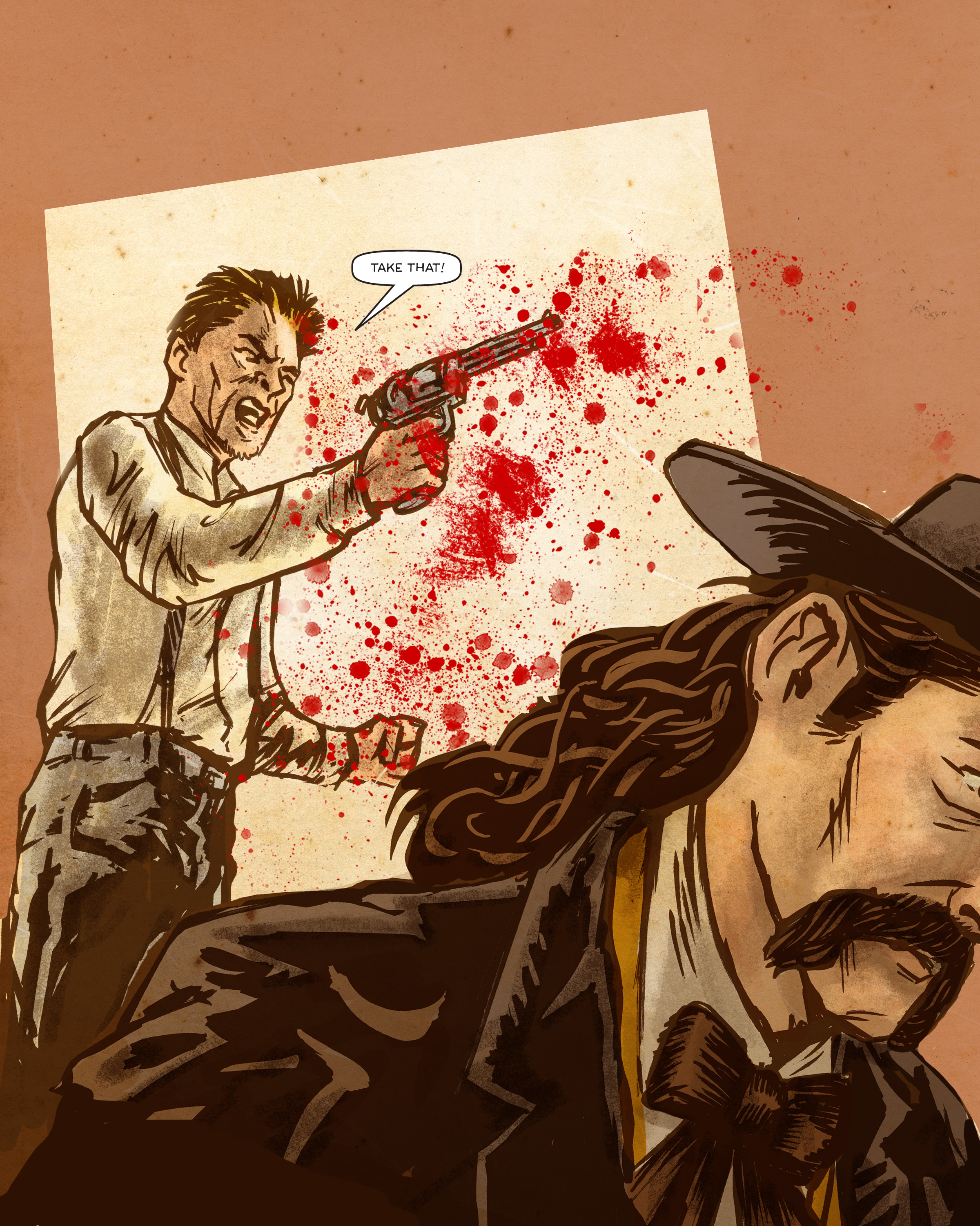Bill Hickok Poker Hand
James Butler Hickok, later known as Wild Bill Hickok, was born on May 27, 1837, to William Alonzo and Polly Butler Hickok in Troy Grove, Ill. Journal file Hickok joined the the Union Army in. (6) The Deadman’s Hand, two black aces and two black eights, nicknamed after the poker hand Wild Bill Hickok was said to hold when he was shot in the back of the head by Jack McCall in Nuttal & Mann’s Saloon in Deadwood. Hickok was a cautious man and usually insisted on sitting in a corner, so no one could sneak up on him. The famed lawman and poker player, Wild Bill Hickok, was shot dead in a poker game while holding that hand. The shooting occurred in 1876 in the town of Deadwood in what would become South Dakota. He was holding two Aces and two Eights when he was shot and killed. Whether on a riverboat atop the Mighty Mississippi or in the smoky dimness of a mining camp saloon, a lucky draw could turn a broken man into a winner.In the days of the frontier west, poker was king with the mustachioed likes of Wild Bill Hickok, Doc Holliday, “Canada” Bill Jones, Wyatt Earp, Bat Masterson, and hundreds of others.
The makeup of poker's dead man's hand has varied through the years. Currently, it is described as a two-pairpoker hand consisting of the black aces and black eights. The pair of aces and eights, along with an unknown hole card, were reportedly held by Old Westfolk hero, lawman, and gunfighterWild Bill Hickok when he was murdered while playing a game. No contemporaneous source, however, records the exact cards he held when killed. Author Frank Wilstach's 1926 book, Wild Bill Hickok: The Prince of Pistoleers, led to the popular modern held conception of the poker hand's contents.
Use of the phrase[edit]
The expression 'dead man's hand' appears to have had some currency in the late 19th and early 20th centuries, although no one connected it to Hickok until the 1920s.[1][2] The earliest detailed reference to it was 1886, where it was described as a 'full house consisting of three jacks and a pair of tens.'[3] Jacks and sevens are called the dead man's hand in the 1903 Encyclopaedia of Superstitions, Folklore, and the Occult Sciences.[4] The 1907 edition of Hoyle's Games refers to the hand as Jacks and eights. [5]
Hickok's hand[edit]
What is currently considered the dead man's hand card combination received its notoriety from a legend that it was the five-card stud or five-card draw hand, held by James Butler Hickok (better known as 'Wild Bill' Hickok) when he was shot in the back of the head by Jack McCall on August 2, 1876, in Nuttal & Mann's Saloon at Deadwood, Dakota Territory. Hickok's final hand purportedly included the aces and eights of both black suits.[6]

According to a book by Western historian Carl W. Breihan, the cards were retrieved from the floor by a man named Neil Christy, who then passed them on to his son. The son, in turn, told Mr. Breihan of the composition of the hand. 'Here is an exact identity of these cards as told to me by Christy's son: the ace of diamonds with a heel mark on it; the ace of clubs; the two black eights, clubs and spades, and the queen of hearts with a small drop of Hickok's blood on it,'[7] though nothing of the sort was reported at the time immediately following the shooting.

Hickok biographer Joseph Rosa wrote about the make-up of the hand: 'The accepted version is that the cards were the ace of spades, the ace of clubs, two black eights, and the queen of clubs as the 'kicker'.'[8] Rosa, however, said that no contemporaneous source can be found for this exact hand.[9] The solidification in gamers' parlance of the dead man's hand as two pairs, black aces and eights, did not come about until after the 1926 publication of Wilstach's book 50 years after Hickok's death.[1]
Legacy[edit]

The Las Vegas Metropolitan Police Department Homicide Division, the Los Angeles Police Department CRASH squad, and the Armed Forces Medical Examiner System all use some variation of the aces and eights dead man's hand in their insignia.[10][11]
See also[edit]
Wild Bill Hickok Last Poker Hand
References[edit]
- ^ ab'Was Wild Bill Hickok Holding the Dead Mans Hand When He Was Slain; The Straight Dope article; retrieved March 2013.
- ^'The Dead Man's Hand Explained – What is the Dead Man's Hand in Poker?'. Casino Wizard.
- ^DiscussionArchived 2007-10-20 at the Wayback Machine; July 3, 1886, article in the Grand Forks Daily Herald; at Linguist List online; retrieved February 2013.
- ^Cora Linn Morrison Daniels, et al; editor; Volume 2.
- ^Edmond Hoyle and editors; Hoyle's Games; 1907; p. 405
- ^Wild Bill Hickok: The Prince of Pistoleers; Frank J. Wilstach; 1926.
- ^Wild Women of the West; Signet; 1982; p. 77.
- ^Wild Bill Hickok: Gunfighter; Joseph G. Rosa; p. 163.
- ^Wild Bill Hickok: The Man and his Myth; Joseph Rosa; 1996.
- ^'Las Vegas Metropolitan Police Department'. Archived from the original on 16 March 2015. Retrieved 20 March 2015.
- ^'Office of the Armed Forces Medical Examiner'. Archived from the original on 15 May 2012. Retrieved 20 March 2015.
External links[edit]

Wild Bill Hickok always had a personal rule to never play poker with his back facing the door. The one time he did, he was shot in the back of the head and killed
“The fateful shot was fired 134 years ago today – August 2, 1876. The shot that rang throughout Deadwood and left its mark forever in Old West history. It was the gunshot that killed James Butler ‘Wild Bill’ Hickok.
Some folks say that Wild Bill knew his days were numbered and that he had told his friend,’Colorado Charlie’ Utter, that he knew Deadwood would be his final camp. Wild Bill, although only 39 years old, had lived a colorful life.
Of the stories told about Wild Bill Hickok, just as many tend to be fiction compared to those that are fact. What can be verified as true is that he made his fame and living as a lawman, military teamster, showman, gunfighter and gambler. Wild Bill’s pursuits took him from his birth state of Illinois to the plains of Kansas and Missouri and eventually to the western frontier regions of Wyoming and South Dakota.
Wild Bill Hickok Poker Hand
After living an adventurous and often questioned lifestyle as a no-holds-barred lawman, Hickock finally made his way to Deadwood Gulch in July of 1876, possibly hoping to quietly live out his days at the poker tables of the booming gold town. And that was the case – for just a couple of weeks.
On August 2, 1876, Wild Bill Hickok was playing poker at Nuttal & Mann’s Saloon No. 10 in Deadwood. Hickok always played by a personal rule that he had to have a chair with his back to the wall.
This day was different.
Because all of the other chairs at the card table were filled and players weren’t willing to give up their seats, Hickok was forced to sit in a chair with his back to the door of the saloon.
Eventually, while Hickok was still playing poker, Jack McCall quietly roamed into the bar and made his way to Wild Bill’s back side. McCall raised a pistol, cursed Hickok and shot him directly in the back of the head – killing him instantly. Hickok’s body slumped forward, revealing his poker hand containing two pair – black aces and black eights.”